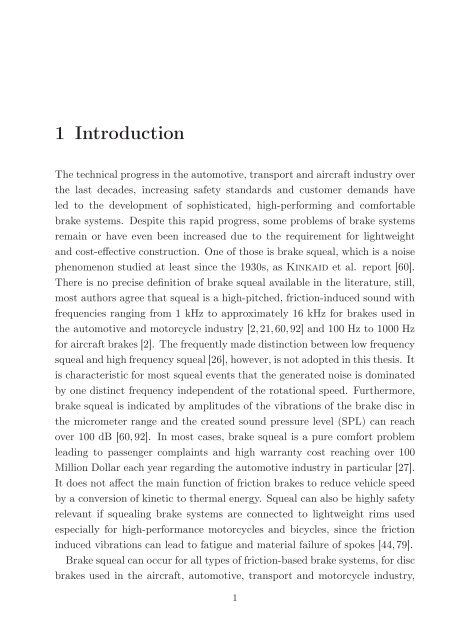Avoidance of brake squeal by a separation of the brake ... - tuprints
Avoidance of brake squeal by a separation of the brake ... - tuprints
Avoidance of brake squeal by a separation of the brake ... - tuprints
You also want an ePaper? Increase the reach of your titles
YUMPU automatically turns print PDFs into web optimized ePapers that Google loves.
1 Introduction<br />
The technical progress in <strong>the</strong> automotive, transport and aircraft industry over<br />
<strong>the</strong> last decades, increasing safety standards and customer demands have<br />
led to <strong>the</strong> development <strong>of</strong> sophisticated, high-performing and comfortable<br />
<strong>brake</strong> systems. Despite this rapid progress, some problems <strong>of</strong> <strong>brake</strong> systems<br />
remain or have even been increased due to <strong>the</strong> requirement for lightweight<br />
and cost-effective construction. One <strong>of</strong> those is <strong>brake</strong> <strong>squeal</strong>, which is a noise<br />
phenomenon studied at least since <strong>the</strong> 1930s, as Kinkaid et al. report [60].<br />
There is no precise definition <strong>of</strong> <strong>brake</strong> <strong>squeal</strong> available in <strong>the</strong> literature, still,<br />
most authors agree that <strong>squeal</strong> is a high-pitched, friction-induced sound with<br />
frequencies ranging from 1 kHz to approximately 16 kHz for <strong>brake</strong>s used in<br />
<strong>the</strong> automotive and motorcycle industry [2,21,60,92] and 100 Hz to 1000 Hz<br />
for aircraft <strong>brake</strong>s [2]. The frequently made distinction between low frequency<br />
<strong>squeal</strong> and high frequency <strong>squeal</strong> [26], however, is not adopted in this <strong>the</strong>sis. It<br />
is characteristic for most <strong>squeal</strong> events that <strong>the</strong> generated noise is dominated<br />
<strong>by</strong> one distinct frequency independent <strong>of</strong> <strong>the</strong> rotational speed. Fur<strong>the</strong>rmore,<br />
<strong>brake</strong> <strong>squeal</strong> is indicated <strong>by</strong> amplitudes <strong>of</strong> <strong>the</strong> vibrations <strong>of</strong> <strong>the</strong> <strong>brake</strong> disc in<br />
<strong>the</strong> micrometer range and <strong>the</strong> created sound pressure level (SPL) can reach<br />
over 100 dB [60,92]. In most cases, <strong>brake</strong> <strong>squeal</strong> is a pure comfort problem<br />
leading to passenger complaints and high warranty cost reaching over 100<br />
Million Dollar each year regarding <strong>the</strong> automotive industry in particular [27].<br />
It does not affect <strong>the</strong> main function <strong>of</strong> friction <strong>brake</strong>s to reduce vehicle speed<br />
<strong>by</strong> a conversion <strong>of</strong> kinetic to <strong>the</strong>rmal energy. Squeal can also be highly safety<br />
relevant if <strong>squeal</strong>ing <strong>brake</strong> systems are connected to lightweight rims used<br />
especially for high-performance motorcycles and bicycles, since <strong>the</strong> friction<br />
induced vibrations can lead to fatigue and material failure <strong>of</strong> spokes [44,79].<br />
Brake <strong>squeal</strong> can occur for all types <strong>of</strong> friction-based <strong>brake</strong> systems, for disc<br />
<strong>brake</strong>s used in <strong>the</strong> aircraft, automotive, transport and motorcycle industry,<br />
1

















